MITSUBISHI L200 2004 (in English) Owners Manual
Manufacturer: MITSUBISHI, Model Year: 2004, Model line: L200, Model: MITSUBISHI L200 2004Pages: 264, PDF Size: 4.14 MB
Page 91 of 264
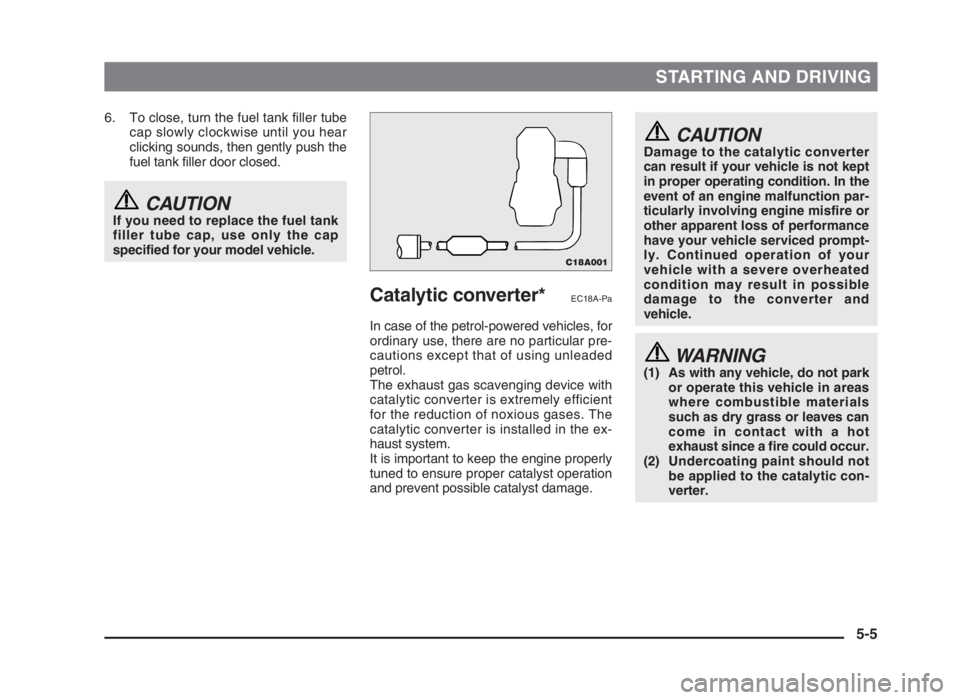
STARTING AND DRIVING
6. To close, turn the fuel tank filler tube
cap slowly clockwise until you hear
clicking sounds, then gently push the
fuel tank filler door closed.
CAUTIONIf you need to replace the fuel tank
filler tube cap, use only the cap
specified for your model vehicle.
CAUTIONDamage to the catalytic converter
can result if your vehicle is not kept
in proper operating condition. In the
event of an engine malfunction par-
ticularly involving engine misfire or
other apparent loss of performance
have your vehicle serviced prompt-
ly. Continued operation of your
vehicle with a severe overheated
condition may result in possible
damage to the converter and
vehicle.
WARNING(1) As with any vehicle, do not park
or operate this vehicle in areas
where combustible materials
such as dry grass or leaves can
come in contact with a hot
exhaust since a fire could occur.
(2) Undercoating paint should not
be applied to the catalytic con-
verter.
Catalytic converter*EC18A-Pa
In case of the petrol-powered vehicles, for
ordinary use, there are no particular pre-
cautions except that of using unleaded
petrol.
The exhaust gas scavenging device with
catalytic converter is extremely efficient
for the reduction of noxious gases. The
catalytic converter is installed in the ex-
haust system.
It is important to keep the engine properly
tuned to ensure proper catalyst operation
and prevent possible catalyst damage.
5-5
C18A001
05engL2_240082_4 22-01-2004 13:04 Page 5-5
Page 92 of 264
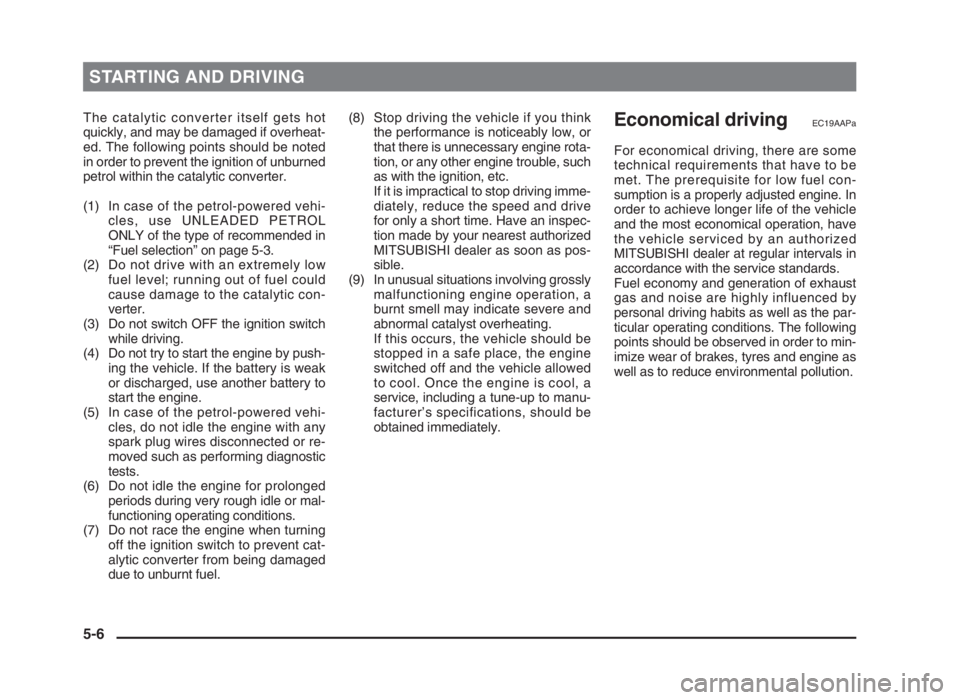
STARTING AND DRIVING
5-6
The catalytic converter itself gets hot
quickly, and may be damaged if overheat-
ed. The following points should be noted
in order to prevent the ignition of unburned
petrol within the catalytic converter.
(1) In case of the petrol-powered vehi-
cles, use UNLEADED PETROL
ONLY of the type of recommended in
“Fuel selection” on page 5-3.
(2) Do not drive with an extremely low
fuel level; running out of fuel could
cause damage to the catalytic con-
verter.
(3) Do not switch OFF the ignition switch
while driving.
(4) Do not try to start the engine by push-
ing the vehicle. If the battery is weak
or discharged, use another battery to
start the engine.
(5) In case of the petrol-powered vehi-
cles, do not idle the engine with any
spark plug wires disconnected or re-
moved such as performing diagnostic
tests.
(6) Do not idle the engine for prolonged
periods during very rough idle or mal-
functioning operating conditions.
(7) Do not race the engine when turning
off the ignition switch to prevent cat-
alytic converter from being damaged
due to unburnt fuel.(8) Stop driving the vehicle if you think
the performance is noticeably low, or
that there is unnecessary engine rota-
tion, or any other engine trouble, such
as with the ignition, etc.
If it is impractical to stop driving imme-
diately, reduce the speed and drive
for only a short time. Have an inspec-
tion made by your nearest authorized
MITSUBISHI dealer as soon as pos-
sible.
(9) In unusual situations involving grossly
malfunctioning engine operation, a
burnt smell may indicate severe and
abnormal catalyst overheating.
If this occurs, the vehicle should be
stopped in a safe place, the engine
switched off and the vehicle allowed
to cool. Once the engine is cool, a
service, including a tune-up to manu-
facturer’s specifications, should be
obtained immediately.Economical drivingEC19AAPa
For economical driving, there are some
technical requirements that have to be
met. The prerequisite for low fuel con-
sumption is a properly adjusted engine. In
order to achieve longer life of the vehicle
and the most economical operation, have
the vehicle serviced by an authorized
MITSUBISHI dealer at regular intervals in
accordance with the service standards.
Fuel economy and generation of exhaust
gas and noise are highly influenced by
personal driving habits as well as the par-
ticular operating conditions. The following
points should be observed in order to min-
imize wear of brakes, tyres and engine as
well as to reduce environmental pollution.
05engL2_240082_4 22-01-2004 13:04 Page 5-6
Page 93 of 264
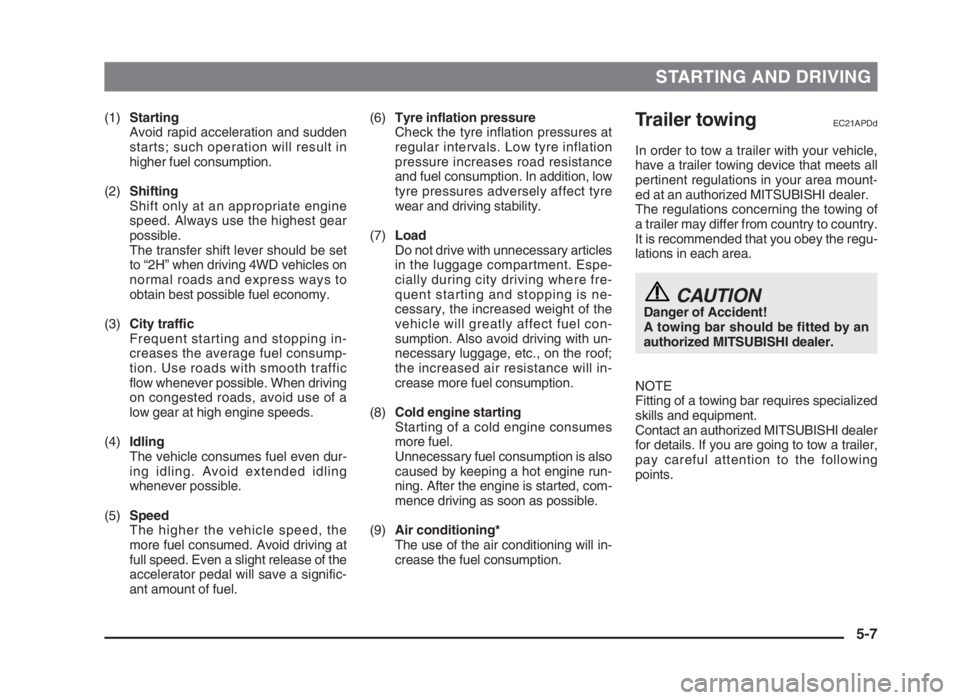
STARTING AND DRIVING
5-7
(1)Starting
Avoid rapid acceleration and sudden
starts; such operation will result in
higher fuel consumption.
(2)Shifting
Shift only at an appropriate engine
speed. Always use the highest gear
possible.
The transfer shift lever should be set
to “2H” when driving 4WD vehicles on
normal roads and express ways to
obtain best possible fuel economy.
(3)City traffic
Frequent starting and stopping in-
creases the average fuel consump-
tion. Use roads with smooth traffic
flow whenever possible. When driving
on congested roads, avoid use of a
low gear at high engine speeds.
(4)Idling
The vehicle consumes fuel even dur-
ing idling. Avoid extended idling
whenever possible.
(5)Speed
The higher the vehicle speed, the
more fuel consumed. Avoid driving at
full speed. Even a slight release of the
accelerator pedal will save a signific-
ant amount of fuel.Trailer towingEC21APDd
In order to tow a trailer with your vehicle,
have a trailer towing device that meets all
pertinent regulations in your area mount-
ed at an authorized MITSUBISHI dealer.
The regulations concerning the towing of
a trailer may differ from country to country.
It is recommended that you obey the regu-
lations in each area.
CAUTIONDanger of Accident!
A towing bar should be fitted by an
authorized MITSUBISHI dealer.
NOTE
Fitting of a towing bar requires specialized
skills and equipment.
Contact an authorized MITSUBISHI dealer
for details. If you are going to tow a trailer,
pay careful attention to the following
points.
(6)Tyre inflation pressure
Check the tyre inflation pressures at
regular intervals. Low tyre inflation
pressure increases road resistance
and fuel consumption. In addition, low
tyre pressures adversely affect tyre
wear and driving stability.
(7)Load
Do not drive with unnecessary articles
in the luggage compartment. Espe-
cially during city driving where fre-
quent starting and stopping is ne-
cessary, the increased weight of the
vehicle will greatly affect fuel con-
sumption. Also avoid driving with un-
necessary luggage, etc., on the roof;
the increased air resistance will in-
crease more fuel consumption.
(8)Cold engine starting
Starting of a cold engine consumes
more fuel.
Unnecessary fuel consumption is also
caused by keeping a hot engine run-
ning. After the engine is started, com-
mence driving as soon as possible.
(9)Air conditioning*
The use of the air conditioning will in-
crease the fuel consumption.
05engL2_240082_4 22-01-2004 13:04 Page 5-7
Page 94 of 264
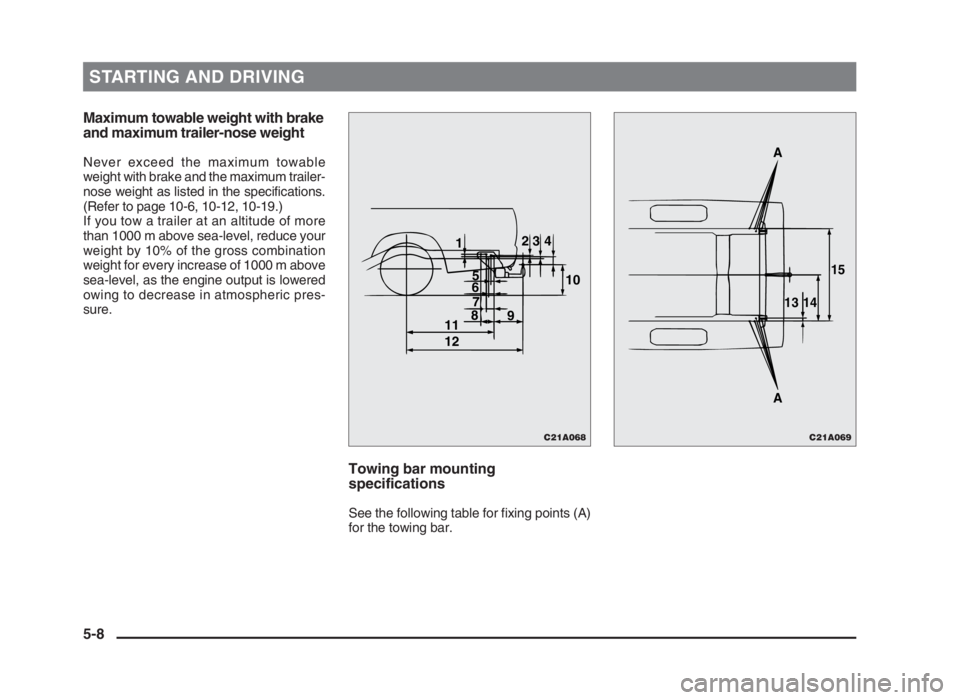
STARTING AND DRIVING
5-8 Maximum towable weight with brake
and maximum trailer-nose weight
Never exceed the maximum towable
weight with brake and the maximum trailer-
nose weight as listed in the specifications.
(Refer to page 10-6, 10-12, 10-19.)
If you tow a trailer at an altitude of more
than 1000 m above sea-level, reduce your
weight by 10% of the gross combination
weight for every increase of 1000 m above
sea-level, as the engine output is lowered
owing to decrease in atmospheric pres-
sure.
Towing bar mounting
specifications
See the following table for fixing points (A)
for the towing bar.
12
5
6
7
8
9
11
1210 34
C21A068C21A069
A
A131415
05engL2_240082_4 22-01-2004 13:04 Page 5-8
Page 95 of 264
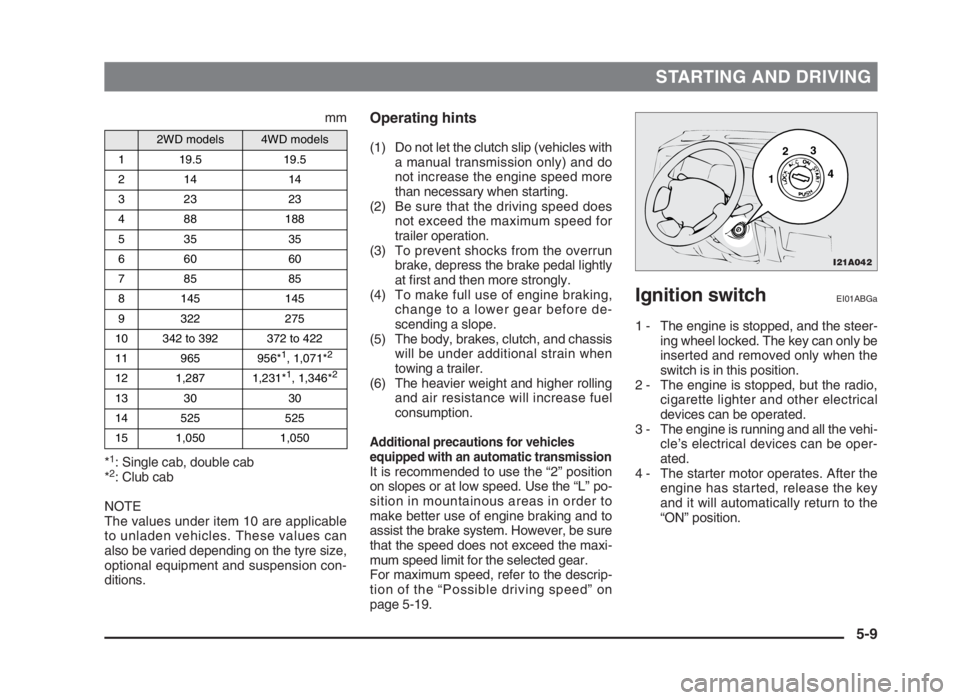
STARTING AND DRIVING
5-9
mm
*
1: Single cab, double cab
*2: Club cab
NOTE
The values under item 10 are applicable
to unladen vehicles. These values can
also be varied depending on the tyre size,
optional equipment and suspension con-
ditions.
Ignition switchEI01ABGa
1 - The engine is stopped, and the steer-
ing wheel locked. The key can only be
inserted and removed only when the
switch is in this position.
2 - The engine is stopped, but the radio,
cigarette lighter and other electrical
devices can be operated.
3 - The engine is running and all the vehi-
cle’s electrical devices can be oper-
ated.
4 - The starter motor operates. After the
engine has started, release the key
and it will automatically return to the
“ON” position.
Operating hints
(1) Do not let the clutch slip (vehicles with
a manual transmission only) and do
not increase the engine speed more
than necessary when starting.
(2) Be sure that the driving speed does
not exceed the maximum speed for
trailer operation.
(3) To prevent shocks from the overrun
brake, depress the brake pedal lightly
at first and then more strongly.
(4) To make full use of engine braking,
change to a lower gear before de-
scending a slope.
(5) The body, brakes, clutch, and chassis
will be under additional strain when
towing a trailer.
(6) The heavier weight and higher rolling
and air resistance will increase fuel
consumption.
Additional precautions for vehicles
equipped with an automatic transmission
It is recommended to use the “2” position
on slopes or at low speed. Use the “L” po-
sition in mountainous areas in order to
make better use of engine braking and to
assist the brake system. However, be sure
that the speed does not exceed the maxi-
mum speed limit for the selected gear.
For maximum speed, refer to the descrip-
tion of the “Possible driving speed” on
page 5-19.
2WD models4WD models
1 19.5 19.5
214 14
323 23
4 88 188
535 35
660 60
785 85
8 145 145
9 322 275
10 342 to 392 372 to 422
11 965 956*
1, 1,071*2
12 1,287 1,231*1, 1,346*2
13 30 30
14 525 525
15 1,050 1,050
I21A042
2
13
4
05engL2_240082_4 22-01-2004 13:04 Page 5-9
Page 96 of 264
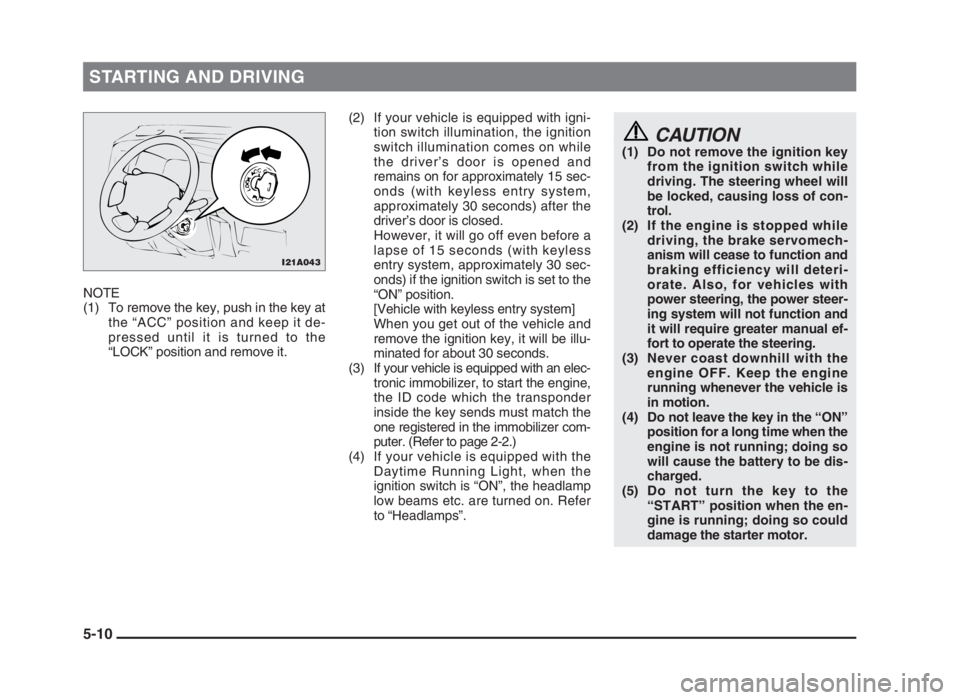
STARTING AND DRIVING
5-10
NOTE
(1) To remove the key, push in the key at
the “ACC” position and keep it de-
pressed until it is turned to the
“LOCK” position and remove it.(2) If your vehicle is equipped with igni-
tion switch illumination, the ignition
switch illumination comes on while
the driver’s door is opened and
remains on for approximately 15 sec-
onds (with keyless entry system,
approximately 30 seconds) after the
driver’s door is closed.
However, it will go off even before a
lapse of 15 seconds (with keyless
entry system, approximately 30 sec-
onds) if the ignition switch is set to the
“ON” position.
[Vehicle with keyless entry system]
When you get out of the vehicle and
remove the ignition key, it will be illu-
minated for about 30 seconds.
(3) If your vehicle is equipped with an elec-
tronic immobilizer, to start the engine,
the ID code which the transponder
inside the key sends must match the
one registered in the immobilizer com-
puter. (Refer to page 2-2.)
(4) If your vehicle is equipped with the
Daytime Running Light, when the
ignition switch is “ON”, the headlamp
low beams etc. are turned on. Refer
to “Headlamps”.
CAUTION(1) Do not remove the ignition key
from the ignition switch while
driving. The steering wheel will
be locked, causing loss of con-
trol.
(2) If the engine is stopped while
driving, the brake servomech-
anism will cease to function and
braking efficiency will deteri-
orate. Also, for vehicles with
power steering, the power steer-
ing system will not function and
it will require greater manual ef-
fort to operate the steering.
(3) Never coast downhill with the
engine OFF. Keep the engine
running whenever the vehicle is
in motion.
(4) Do not leave the key in the “ON”
position for a long time when the
engine is not running; doing so
will cause the battery to be dis-
charged.
(5) Do not turn the key to the
“START” position when the en-
gine is running; doing so could
damage the starter motor.
I21A043
05engL2_240082_4 22-01-2004 13:04 Page 5-10
Page 97 of 264
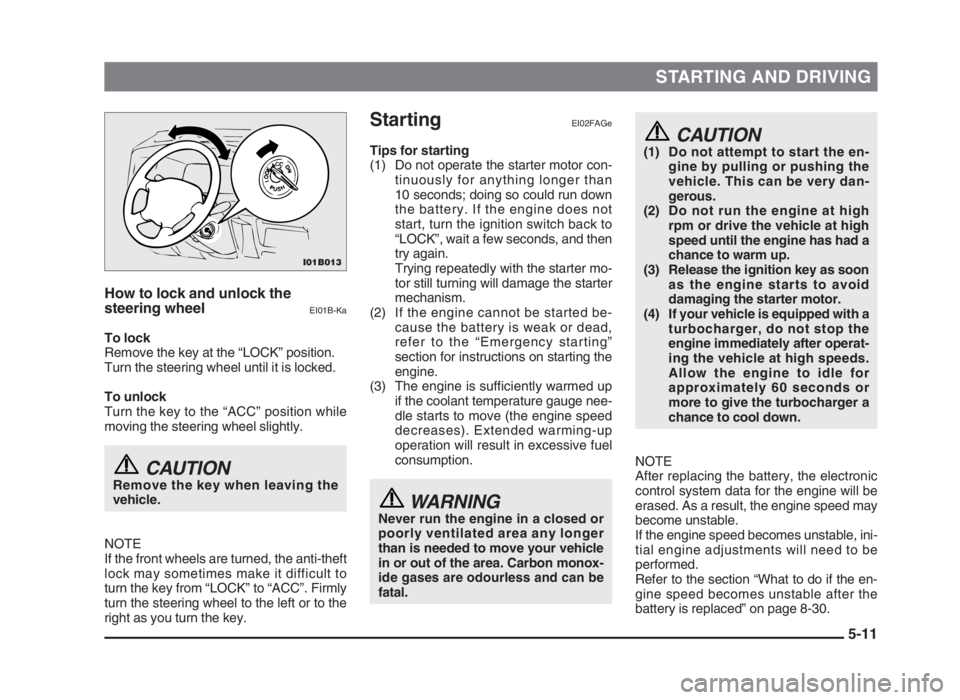
STARTING AND DRIVING
5-11 How to lock and unlock the
steering wheel
EI01B-Ka
To lock
Remove the key at the “LOCK” position.
Turn the steering wheel until it is locked.
To unlock
Turn the key to the “ACC” position while
moving the steering wheel slightly.
CAUTIONRemove the key when leaving the
vehicle.
NOTE
If the front wheels are turned, the anti-theft
lock may sometimes make it difficult to
turn the key from “LOCK” to “ACC”. Firmly
turn the steering wheel to the left or to the
right as you turn the key.
CAUTION(1) Do not attempt to start the en-
gine by pulling or pushing the
vehicle. This can be very dan-
gerous.
(2) Do not run the engine at high
rpm or drive the vehicle at high
speed until the engine has had a
chance to warm up.
(3) Release the ignition key as soon
as the engine starts to avoid
damaging the starter motor.
(4) If your vehicle is equipped with a
turbocharger, do not stop the
engine immediately after operat-
ing the vehicle at high speeds.
Allow the engine to idle for
approximately 60 seconds or
more to give the turbocharger a
chance to cool down.
NOTE
After replacing the battery, the electronic
control system data for the engine will be
erased. As a result, the engine speed may
become unstable.
If the engine speed becomes unstable, ini-
tial engine adjustments will need to be
performed.
Refer to the section “What to do if the en-
gine speed becomes unstable after the
battery is replaced” on page 8-30.
StartingEI02FAGe
Tips for starting
(1) Do not operate the starter motor con-
tinuously for anything longer than
10 seconds; doing so could run down
the battery. If the engine does not
start, turn the ignition switch back to
“LOCK”, wait a few seconds, and then
try again.
Trying repeatedly with the starter mo-
tor still turning will damage the starter
mechanism.
(2) If the engine cannot be started be-
cause the battery is weak or dead,
refer to the “Emergency starting”
section for instructions on starting the
engine.
(3) The engine is sufficiently warmed up
if the coolant temperature gauge nee-
dle starts to move (the engine speed
decreases). Extended warming-up
operation will result in excessive fuel
consumption.
WARNING
Never run the engine in a closed or
poorly ventilated area any longer
than is needed to move your vehicle
in or out of the area. Carbon monox-
ide
gases are odourless and can be
fatal.
I01B013
05engL2_240082_4 22-01-2004 13:04 Page 5-11
Page 98 of 264
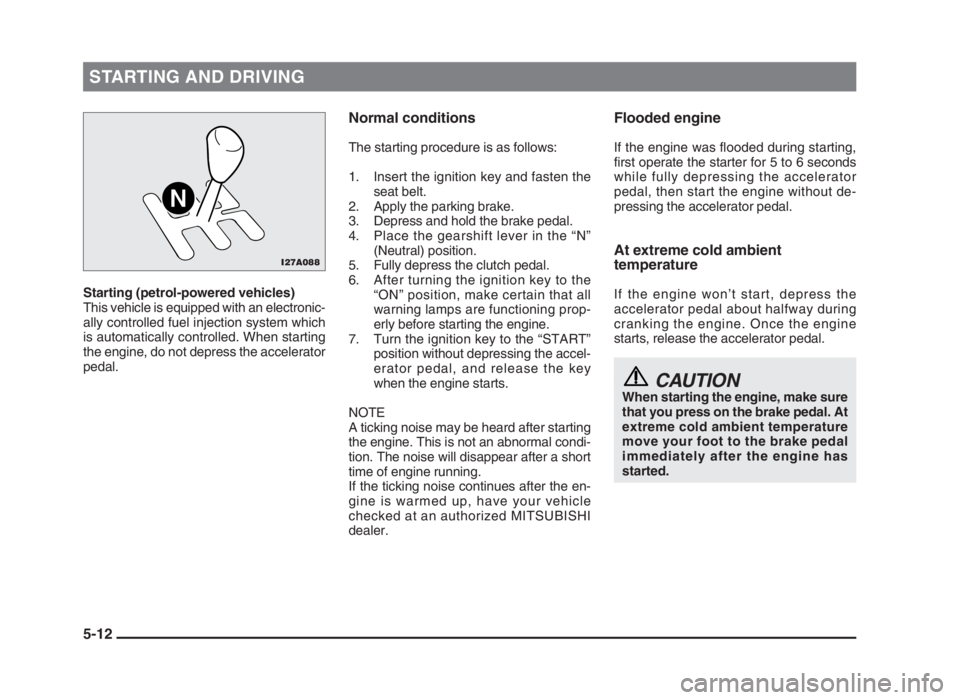
STARTING AND DRIVING
5-12
Starting (petrol-powered vehicles)
This vehicle is equipped with an electronic-
ally controlled fuel injection system which
is automatically controlled. When starting
the engine, do not depress the accelerator
pedal.
Normal conditions
The starting procedure is as follows:
1. Insert the ignition key and fasten the
seat belt.
2. Apply the parking brake.
3. Depress and hold the brake pedal.
4. Place the gearshift lever in the “N”
(Neutral) position.
5. Fully depress the clutch pedal.
6. After turning the ignition key to the
“ON” position, make certain that all
warning lamps are functioning prop-
erly before starting the engine.
7. Turn the ignition key to the “START”
position without depressing the accel-
erator pedal, and release the key
when the engine starts.
NOTE
A ticking noise may be heard after starting
the engine. This is not an abnormal condi-
tion. The noise will disappear after a short
time of engine running.
If the ticking noise continues after the en-
gine is warmed up, have your vehicle
checked at an authorized MITSUBISHI
dealer.
Flooded engine
If the engine was flooded during starting,
first operate the starter for 5 to 6 seconds
while fully depressing the accelerator
pedal, then start the engine without de-
pressing the accelerator pedal.
At extreme cold ambient
temperature
If the engine won’t start, depress the
accelerator pedal about halfway during
cranking the engine. Once the engine
starts, release the accelerator pedal.
CAUTIONWhen starting the engine, make sure
that you press on the brake pedal. At
extreme cold ambient temperature
move your foot to the brake pedal
immediately after the engine has
started.
I27A088
05engL2_240082_4 22-01-2004 13:04 Page 5-12
Page 99 of 264
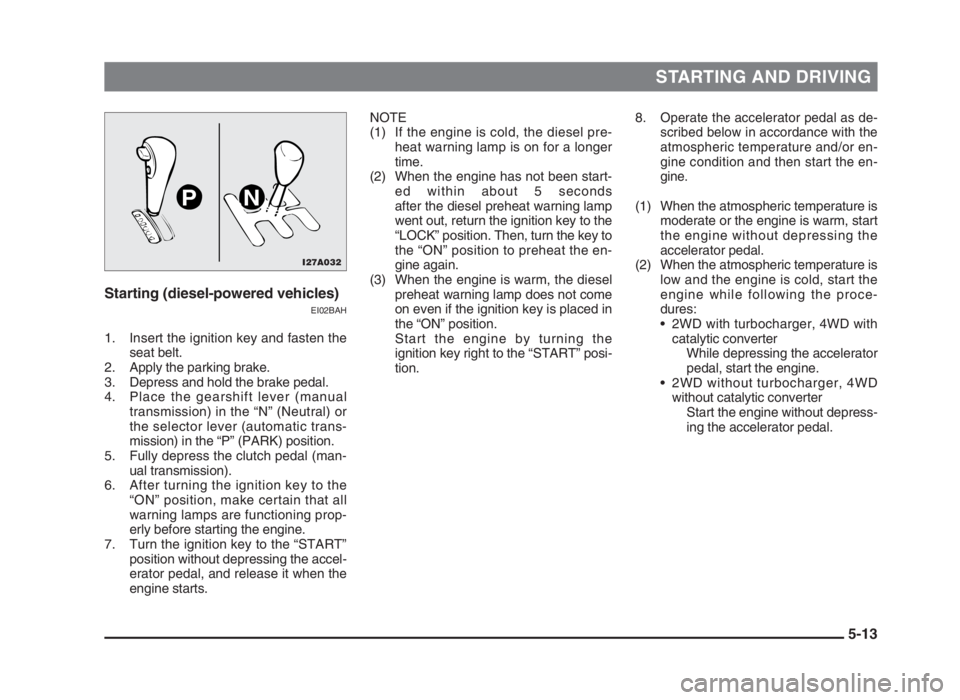
STARTING AND DRIVING
5-13 Starting (diesel-powered vehicles)
EI02BAH
1. Insert the ignition key and fasten the
seat belt.
2. Apply the parking brake.
3. Depress and hold the brake pedal.
4. Place the gearshift lever (manual
transmission) in the “N” (Neutral) or
the selector lever (automatic trans-
mission) in the “P” (PARK) position.
5. Fully depress the clutch pedal (man-
ual transmission).
6. After turning the ignition key to the
“ON” position, make certain that all
warning lamps are functioning prop-
erly before starting the engine.
7. Turn the ignition key to the “START”
position without depressing the accel-
erator pedal, and release it when the
engine starts.8.
Operate the accelerator pedal as de-
scribed below in accordance with the
atmospheric temperature and/or en-
gine condition and then start the en-
gine.
(1) When the atmospheric temperature is
moderate or the engine is warm, start
the engine without depressing the
accelerator pedal.
(2) When the atmospheric temperature is
low and the engine is cold, start the
engine while following the proce-
dures:
• 2WD with turbocharger, 4WD with
catalytic converter
While depressing the accelerator
pedal, start the engine.
• 2WD without turbocharger, 4WD
without catalytic converter
Start the engine without depress-
ing the accelerator pedal. NOTE
(1) If the engine is cold, the diesel pre-
heat warning lamp is on for a longer
time.
(2) When the engine has not been start-
ed within about 5 seconds
after the diesel preheat warning lamp
went out, return the ignition key to the
“LOCK” position. Then, turn the key to
the “ON” position to preheat the en-
gine again.
(3) When the engine is warm, the diesel
preheat warning lamp does not come
on even if the ignition key is placed in
the “ON” position.
Start the engine by turning the
ignition key right to the “START” posi-
tion.
I27A032
PN
05engL2_240082_4 22-01-2004 13:04 Page 5-13
Page 100 of 264
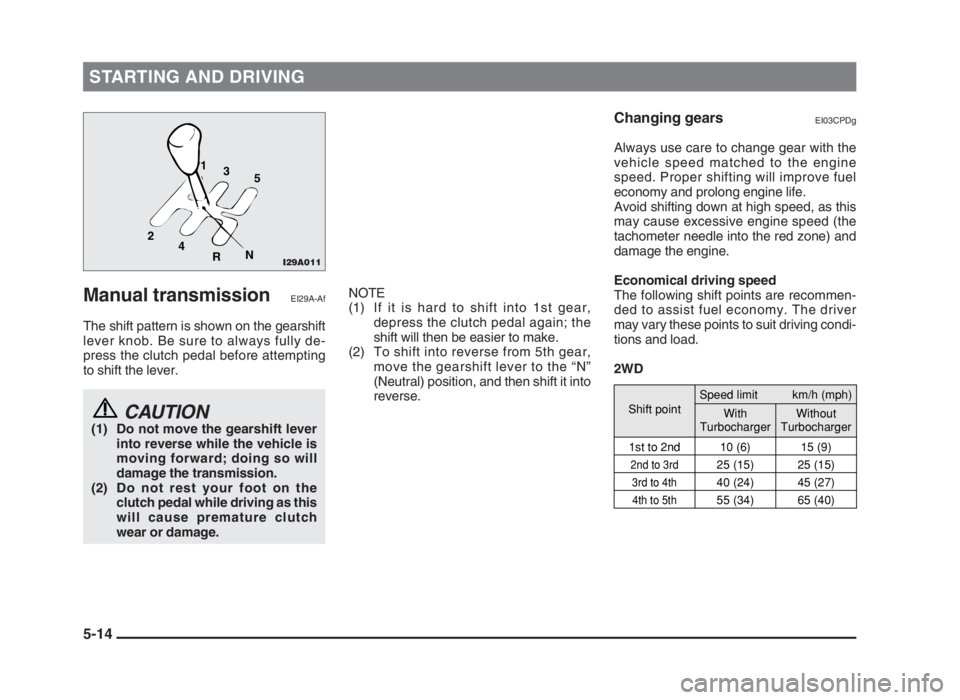
STARTING AND DRIVING
5-14
Shift pointSpeed limit km/h (mph)
With
TurbochargerWithout
Turbocharger
1st to 2nd 10 (6) 15 (9)
2nd to 3rd25 (15) 25 (15)
3rd to 4th40 (24) 45 (27)
4th to 5th55 (34) 65 (40)
Manual transmissionEI29A-Af
The shift pattern is shown on the gearshift
lever knob. Be sure to always fully de-
press the clutch pedal before attempting
to shift the lever.
CAUTION(1) Do not move the gearshift lever
into reverse while the vehicle is
moving forward; doing so will
damage the transmission.
(2) Do not rest your foot on the
clutch pedal while driving as this
will cause premature clutch
wear or damage.
NOTE
(1) If it is hard to shift into 1st gear,
depress the clutch pedal again; the
shift will then be easier to make.
(2) To shift into reverse from 5th gear,
move the gearshift lever to the “N”
(Neutral) position, and then shift it into
reverse.
Changing gearsEI03CPDg
Always use care to change gear with the
vehicle speed matched to the engine
speed. Proper shifting will improve fuel
economy and prolong engine life.
Avoid shifting down at high speed, as this
may cause excessive engine speed (the
tachometer needle into the red zone) and
damage the engine.
Economical driving speed
The following shift points are recommen-
ded to assist fuel economy. The driver
may vary these points to suit driving condi-
tions and load.
2WD
I29A011
2
4
RN5 3 1
05engL2_240082_4 22-01-2004 13:04 Page 5-14